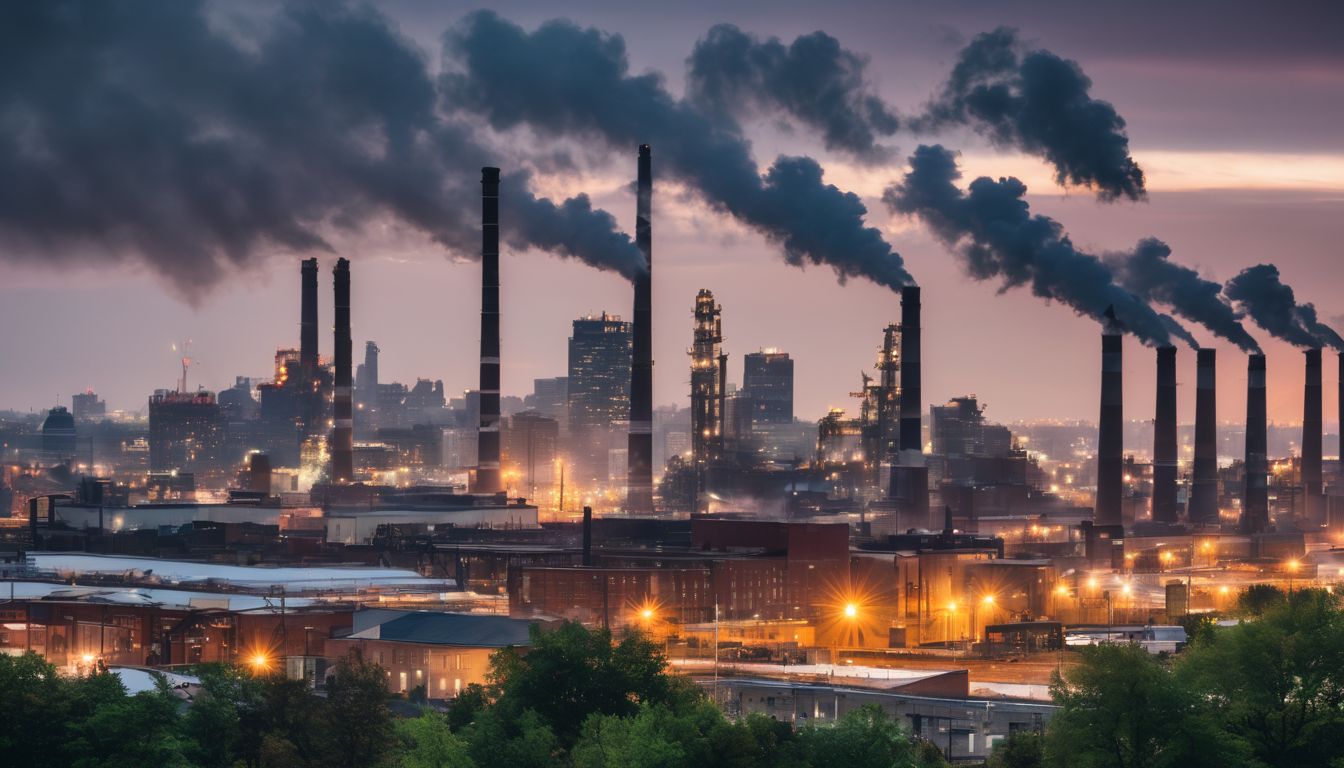Many of us worry about Earth’s rising temperatures and wonder what can be done. Since the 1990s, global agreements have shaped our fight against climate change, with the Paris Agreement leading the charge.
This blog post will untangle these complex accords in simple terms, revealing their impact and how they’re shaping our planet’s future. Keep reading to find out why we all need to act together now.
Key Takeaways
- Countries around the world are uniting to tackle climate change through international agreements like the Paris Agreement, which aims to keep global warming below 2 degrees Celsius. Nations commit to reducing emissions and supporting each other with finance and technology.
- The top greenhouse gas emitters have shifted over time, with China and the USA now leading in annual CO2-equivalent emissions. Long-term historical contributions show these two countries along with the European Union as major contributors since 1850.
- Since signing the Paris Agreement, nations have taken steps such as setting targets for emission reductions, enhancing climate policies, investing in clean technologies, developing adaptation strategies, increasing public awareness on sustainability, and engaging non-state actors in action plans.
- Alternative agreements may offer tailored solutions for specific regions or sectors. These could complement global efforts by focusing on innovative approaches to environmental challenges within smaller groups of countries or industries.
- Tracking progress is crucial; countries must regularly report their achievements in reducing emissions while continuing investments in sustainable development and adapting to climate impacts. Global cooperation remains key for collectively addressing the urgent issue of climate change.
Global Climate Change Agreements: A Brief History
Since the 1990s, there have been international efforts to address climate change through key accords such as the Paris Agreement. These agreements have shaped global climate policy and continue to influence negotiations and actions on a worldwide scale.
International efforts since the 1990s
Countries around the globe began uniting in the 1990s to tackle climate change, recognising its threat to our planet. In 1992, they established a milestone with the creation of the United Nations Framework Convention on Climate Change (UNFCCC).
This foundational treaty set the stage for future international treaties aimed at reducing greenhouse gas emissions and strengthening global climate action.
Following this, nations met annually in conferences known as COPs – Conference of Parties – to negotiate and update their commitments. The Kyoto Protocol came into force in 2005, making it one of the first binding agreements requiring industrialised countries to cut their carbon footprints.
These international efforts have shaped environmental governance and underscored the importance of intergovernmental cooperation in addressing global warming.
Key accords, including the Paris Agreement
Since the 1990s, international efforts to combat climate change have resulted in key accords such as the Paris Agreement. This landmark agreement aims to limit global warming to well below 2 degrees Celsius above pre-industrial levels and pursue efforts to limit the temperature increase to 1.5 degrees Celsius.
Signatory countries commit to nationally determined contributions (NDCs) regarding emissions reduction and adaptation measures, supported by finance, technology transfer, and capacity-building for developing nations.
The Paris Agreement is crucial in setting a pathway for sustainable development while addressing climate change comprehensively. Its success relies on robust implementation of NDCs and transparent reporting mechanisms that track progress towards achieving emissions reduction targets.
Consensus on the Science of Climate Change
Climate change is a reality, and the scientific consensus points to human activities as the primary cause. Countries are striving to limit global temperature rise to below 1.5°C in order to avoid catastrophic consequences for the planet.
The reality of climate change and its causes
Climate change is a result of human activities, such as burning fossil fuels and deforestation, which release greenhouse gases into the atmosphere. These gases trap heat, leading to a rise in global temperatures.
The main contributors to this phenomenon are carbon dioxide (CO2), methane (CH4), and nitrous oxide (N2O). As a consequence, the Earth’s climate is changing rapidly, causing extreme weather events, rising sea levels, and disruption to ecosystems.
Furthermore, changes in land use and industrial processes have also led to an increase in emissions since the start of the Industrial Revolution. It is crucial for individuals and nations to address these causes by transitioning towards sustainable energy sources and engaging in reforestation efforts.
Why countries aim to keep global temperature rise below 1.5°C
Countries aim to keep global temperature rise below 1.5°C because it is crucial for preventing the most catastrophic impacts of climate change, which include more frequent extreme weather events like hurricanes, droughts, and floods.
Limiting the temperature increase is vital to protect vulnerable ecosystems such as coral reefs and polar regions. Furthermore, a 1.5°C limit offers a greater chance of preserving biodiversity while reducing risks to human health and livelihoods.
Achieving this target requires rapid and substantial reductions in greenhouse gas emissions from human activities such as burning fossil fuels, deforestation, and industrial processes.
To meet the 1.5°C goal will require unprecedented transitions across various sectors including energy, transport, land use management, and industry towards low-carbon practices supported by new technologies and sustainable practices.
Top greenhouse gas emitters since 1850 and in 2021
Understanding the top greenhouse gas emitters over time is key to addressing climate change effectively. Here’s a look at the nations that have contributed most to emissions historically since 1850 and their standing in 2021.
| Rank | Country (since 1850) | Total emissions (billion tonnes CO2-equivalent) | Country (in 2021) | Annual emissions (billion tonnes CO2-equivalent) |
|---|---|---|---|---|
| 1 | United States | 400 | China | 10.06 |
| 2 | China | 200 | United States | 5.41 |
| 3 | European Union (27) | 150 | European Union (27) | 2.5 |
| 4 | Russia | 100 | India | 2.65 |
| 5 | India | 50 | Russia | 1.71 |
| 6 | Brazil | 25 | Japan | 1.15 |
| 7 | Indonesia | 20 | Brazil | 0.98 |
| 8 | Japan | 15 | Indonesia | 0.75 |
| 9 | Germany | 10 | Iran | 0.72 |
| 10 | United Kingdom | 9 | South Korea | 0.65 |
These figures highlight the shift in top emitters over time, with China and the United States consistently leading. This data underscores the need for sustained and strategic global efforts to curb emissions.
Progress and Effectiveness of Climate Change Agreements
Country commitments and progress since the Paris Agreement have shown mixed results, with some nations making significant strides in reducing emissions while others have struggled to meet their targets.
Alternative agreements, such as the Kyoto Protocol and the Copenhagen Accord, have been proposed but face challenges in terms of feasibility and implementation. Recommended resources for further reading include reports from reputable environmental organisations and academic studies on global climate governance.
Country commitments and progress since the Paris Agreement
Since the Paris Agreement, countries have made significant commitments and strides in addressing climate change. Here are the key developments:
- Reduction of Greenhouse Gas Emissions: Many countries have set ambitious targets to reduce their greenhouse gas emissions, with a focus on transitioning to renewable energy sources and improving energy efficiency.
- Enhanced Climate Policies: Nations have implemented and strengthened climate policies, including carbon pricing mechanisms, renewable energy subsidies, and regulations to limit emissions from industries and transport.
- Investment in Clean Technologies: Governments are investing in clean technologies such as electric vehicles, carbon capture and storage, sustainable agriculture practices, and smart grid systems to reduce carbon footprints.
- Adaptation Strategies: Countries are developing and implementing adaptation strategies to mitigate the impact of climate change on vulnerable communities, ecosystems, and infrastructure.
- International Collaboration: Collaborative efforts between countries have increased through knowledge sharing, capacity building, and financial support for developing nations to bolster their resilience against climate change effects.
- Public Awareness Campaigns: Governments are actively engaging in public awareness campaigns to educate citizens about the importance of sustainability, conservation efforts, and individual contributions towards mitigating climate change impacts.
- Accountability Mechanisms: There is a growing emphasis on accountability as countries strive to monitor their progress towards meeting their commitments under the Paris Agreement through transparent reporting mechanisms.
- Engagement with Non-State Actors: Governments are collaborating with non-state actors such as businesses, civil society organisations, and academic institutions to accelerate climate action through innovation and sustainable practices.
Alternative agreements and their feasibility
Alternative climate change agreements, such as regional or sector-specific pacts, present feasible options for enhancing mitigation measures. These agreements could be enacted among smaller groups of countries or even within specific industries to target emissions more effectively.
By focusing on tailored solutions and cooperation, these alternative accords address the unique needs and challenges of different regions or sectors, potentially leading to more robust and rapid progress in reducing polluting activities.
Exploring diverse approaches beyond the traditional global treaties may offer new avenues for environmental accords. These initiatives could foster innovation and creative solutions while complementing existing international efforts.
Recommended resources for further reading
Looking for more information on climate change agreements? Dive deeper with these recommended resources:
- United Nations Framework Convention on Climate Change (UNFCCC) website: Find official documents, reports, and updates on international climate negotiations.
- Intergovernmental Panel on Climate Change (IPCC) reports: Access comprehensive assessments of scientific research on climate change, including impacts, adaptation, and mitigation.
- World Resources Institute (WRI) publications: Explore insightful analysis and policy briefs on global climate negotiations and the effectiveness of different agreements.
- International Institute for Sustainable Development (IISD) resources: Discover in-depth studies and articles on the politics of international environmental agreements and their implementation.
- National Geographic’s climate change section: Read engaging articles, infographics, and interactive features to deepen your understanding of the global impact of climate change.
- Yale Center for Environmental Law & Policy database: Delve into an extensive collection of legal resources, scholarly articles, and case studies related to international environmental treaties and protocols.
Key Elements of the Paris Agreement
Nationally Determined Contributions (NDCs) and long-term strategies are essential for achieving the goals of the Paris Agreement. For more detailed information on these key elements, be sure to check out recommended resources for further reading.
Nationally Determined Contributions (NDCs) and long-term strategies
Each country sets its own NDCs for reducing greenhouse gas emissions. These contributions are determined at the national level and submitted to the United Nations. Long-term strategies outline each nation’s vision for achieving emission reduction targets over time.
NDCs are a critical part of global efforts to combat climate change and are essential in driving progress towards mitigating its impact. Aligning with long-term strategies, these commitments play a pivotal role in shaping international climate policy and fostering collaboration among nations.
Support for adaptation, finance, technology, and capacity-building
Nations pledged to support adaptation, finance, technology, and capacity-building as part of the Paris Agreement. This includes assisting vulnerable countries in adapting to climate impacts and transitioning to sustainable practices.
Financial assistance is vital for developing nations striving to mitigate and adapt to climate change. Technology transfer ensures access to clean energy solutions while capacity-building empowers communities to address environmental challenges effectively.
Tracking progress and achievements so far
Nations keep tabs on country commitments and efforts since the Paris Agreement. The agreements aim to mitigate greenhouse gas emissions and minimise climate change impacts. Many nations have made strides in renewable energy adoption and emission reduction.
Climate adaptation measures also show progress, with innovative strategies improving resilience against extreme weather events. Financial support for developing countries in their climate actions highlights global solidarity.
Global cooperation drives these achievements, forming a united front against climate change. As countries continue to work towards their NDCs, transparency and accountability remain essential for tracking global progress.
Conclusion: The Importance of Global Cooperation in Combating Climate Change
Global cooperation is vital in addressing the challenges of climate change. Nations must work together to find solutions and reduce global emissions. Together, we can develop strategies to mitigate the impact of climate change and build a sustainable future for generations to come.
It’s essential that every country plays its part in this global effort.
FAQs
1. What are climate change agreements?
Climate change agreements are international treaties where countries commit to reducing polluting activities and support mitigation efforts against global warming.
2. How do countries work together on these agreements?
Countries engage in multilateral environmental agreements and climate diplomacy to collaborate on strategies for adaptation to climate change and to share responsibilities.
3. Why is it important for nations to agree on climate action?
It’s crucial because working together through international treaty commitments can lead to more effective reduction of greenhouse gases and help protect our planet.
4. Do these agreements focus only on cutting down emissions?
No, aside from targeting the reduction of emissions, they also emphasise adaptation strategies helping communities adjust to the impacts of climate change effectively.





